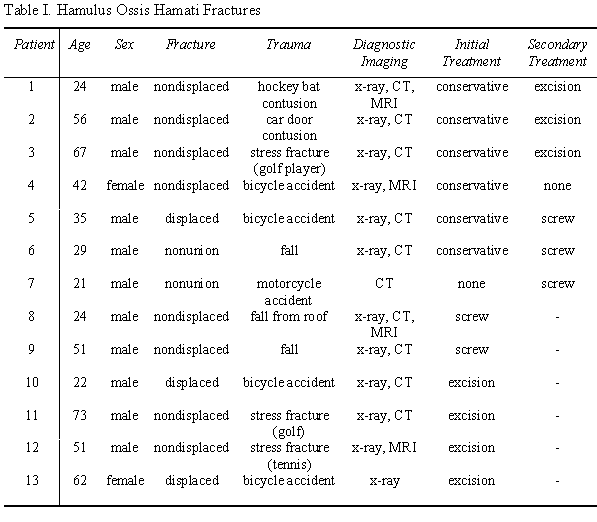Wednesday, October 29, 2003
3731
P43: Evaluation of Therapeutic Strategies in Hook of Hamate Fractures
Fractures of the hamate hook are rare events, making up only 2-4% of all carpal fractures. They may occur by different mechanisms, including a directly applied force in a fall or crush injury, a shearing force applied by the extrinsic flexor tendons of the ring and small finger, repeated microtrauma during forceful grip in several sports using a racquet or bat, and combinations of these forces. Although these fractures are uncommon, the increasing popularity of golf and other racquet sports has led to a higher incidence of stress fractures of the hamate hook. The therapy of choice in non displaced hook of hamate fractures is conservative by lower arm splinting. Displaced fractures should be treated operatively, whereby excision of the fragment or open reduction and internal fixation (ORIF) are described. A hamulus ossis hamati fracture was verified in 13 patients (mean age: 42.8 years; range: 21 - 73 years) including 11 males and 2 females. In 10 patients hamate hook fractures resulted from a direct blow to the proximal part of the palm during different daily activities. In 3 patients stress fractures occurred during sports activities, involving the nondominant hand in 2 patients (golf) and the dominant hand in 1 patient (tennis). Diagnostic imaging included conventional radiographs in two planes in all of the 13 patients, carpal tunnel view in 7 patients (54%), CT scan in 9 patients (69%), and MRI in 5 patients (38%). All patients presented a fracture of the hook close to the base. In 7 patients (54%) conservative treatment was initiated immediatly after trauma with a lower arm cast for 6 weeks, in 4 patients (31%) the fragment was excised and in 2 patients (15%) an ORIF was performed using a screw. In 6 of the 7 patients treated conservatively a delayed consolidation of the fracture with persisting clinical symptoms was found. All of those patients were treated operatively, whereby 3 patients (23%) underwent excision and 3 patients screw fixation. All surgical treatments included release of Guyon´s canal. The group of patients undergoing excision received functional treatment with physiotherapeutic exercises without any limitation of movement. The patients undergoing ORIF were immobilized with a lower arm cast for 2 weeks followed by physiotherapy and were instructed to avoid any strain of the injured hand for a total of 6 weeks. In all 6 cases of delayed surgery elemination of symptoms was achieved. Patients operated primarily were asymptomatic three months after surgery. In conclusion, the clinical outcome of patients treated conservatively was disappointing. Therefore, primary surgical treatment is recommended. In our patients excision and ORIF led to comparable results.
View Synopsis (.doc format, 144.0 kb)
See more of Posters
Back to Plastic Surgery 2003 Complete Scientific Program
Back to Plastic Surgery 2003 Meeting home

